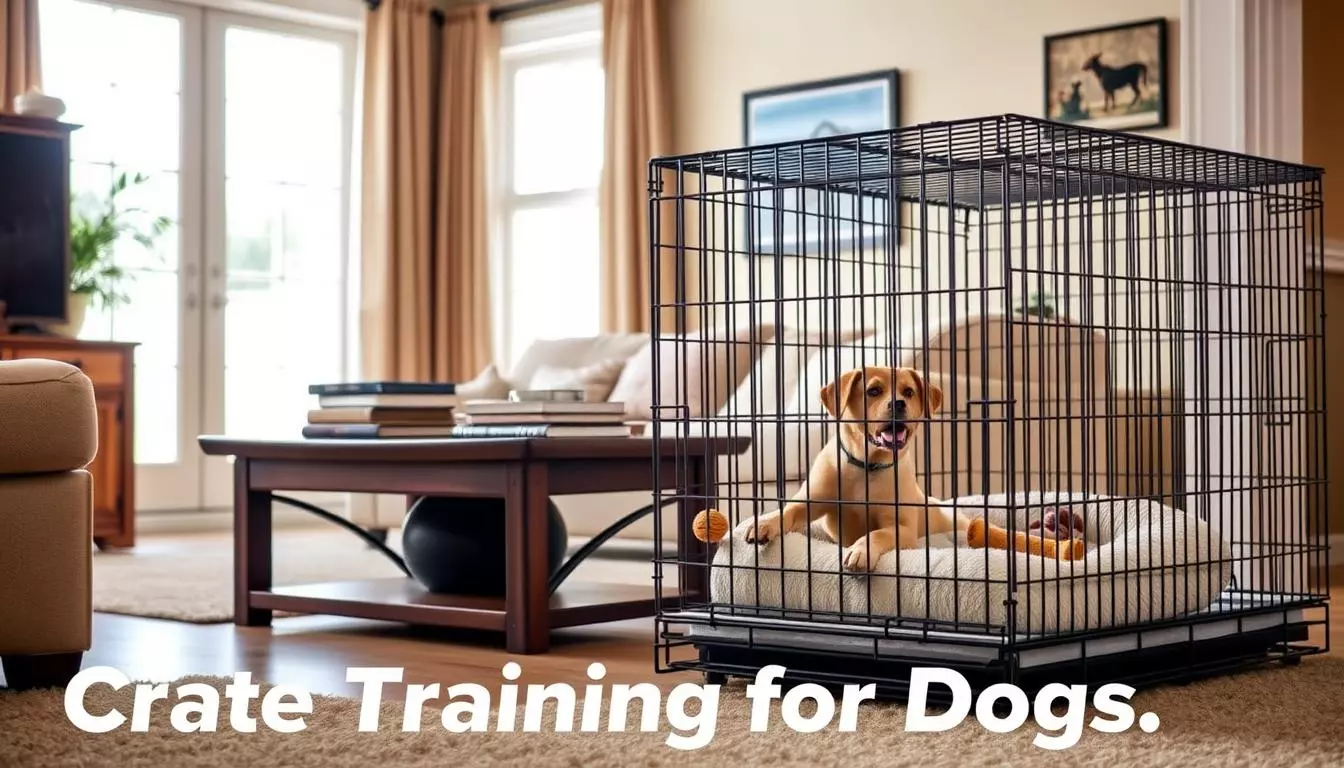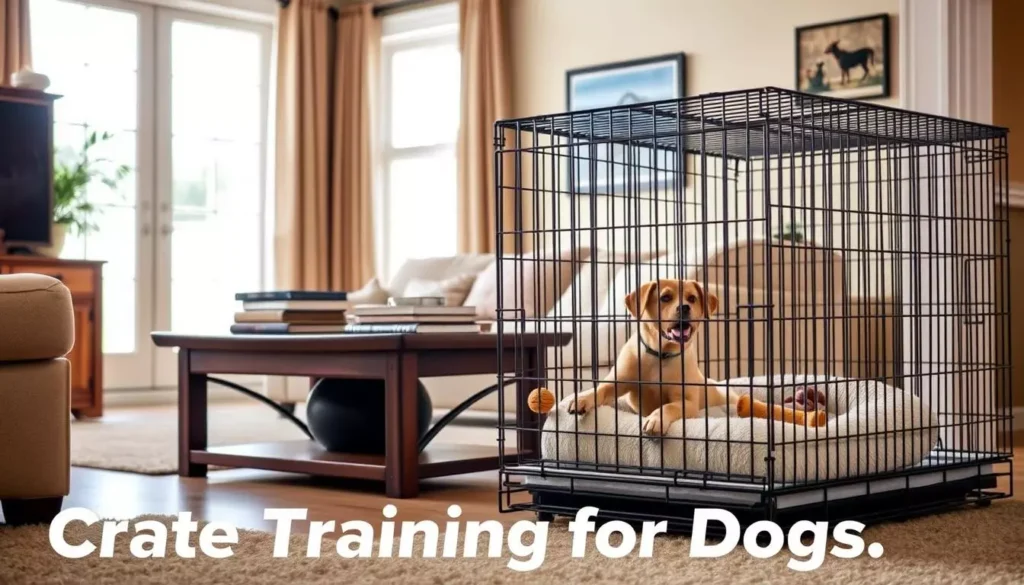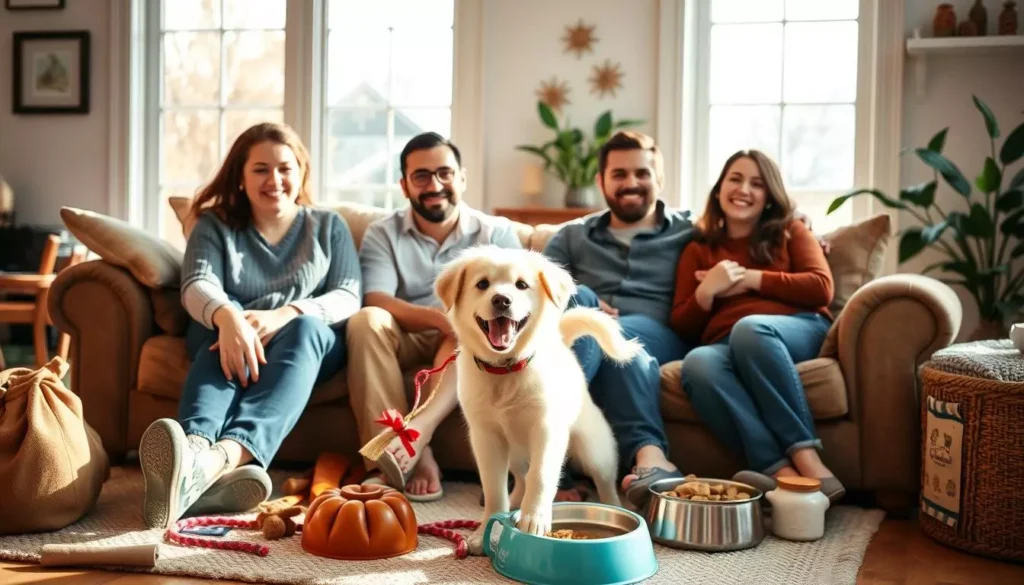When I brought my rescue dog home, I felt overwhelmed. Crate training was my solution to make her feel safe. It helped her feel confident, set boundaries, and feel protected.
Dogs are naturally drawn to small, enclosed spaces. A crate is more than a training tool; it's a personal sanctuary. It meets their emotional needs.
This guide will show you how to crate train your dog positively. It's for both new and experienced dog owners. You'll learn strategies to make crate training a success.
Key Takeaways
- Crate training provides dogs with a sense of security
- Dogs have natural den-dwelling instincts
- Proper crate training reduces anxiety
- A crate can be a safe personal space for your dog
- Patience and positive reinforcement are crucial
Understanding the Importance of Crate Training
Dog crate training is more than just a way to manage your pet. It's a powerful tool that uses your dog's natural instincts. It also supports their behavioral growth. Knowing why crate training is good for your dog can change how you care for and train them.
Crate training has many benefits beyond just keeping your dog in one place. Let's look at the main reasons why it's so effective for dogs of all ages and types.
Natural Den Instincts in Dogs
Dogs come from wild ancestors who liked safe, enclosed spaces. A crate is like the den they naturally seek. This natural preference makes crate training easy for most dogs.
- Provides a sense of security
- Replicates natural wolf den behaviors
- Creates a personal safe space
Safety and Security Benefits
When you think about crate training, safety is key. Crates stop destructive behavior and keep your home and dog safe when you're not watching.
| Safety Aspect | Benefit |
|---|---|
| Prevents Destruction | Protects furniture and household items |
| Injury Prevention | Keeps dog away from dangerous objects |
| Controlled Environment | Reduces anxiety and potential stress-related behaviors |
Role in Behavioral Development
Why is crate training good for your dog's growth? It teaches self-control, provides structure, and sets boundaries. Regular crate training can greatly improve your dog's discipline and emotional balance.
"A well-trained dog is a confident dog, and crate training is a key step in building that confidence." - Professional Dog Trainer
By understanding these key points about crate training, you can create a positive, supportive space for your dog.
Selecting the Perfect Crate for Your Dog
Choosing the right inside dog crate is key for your pet's comfort and training. The perfect crate is a safe space and a training tool. It supports your dog's natural instincts and provides security.
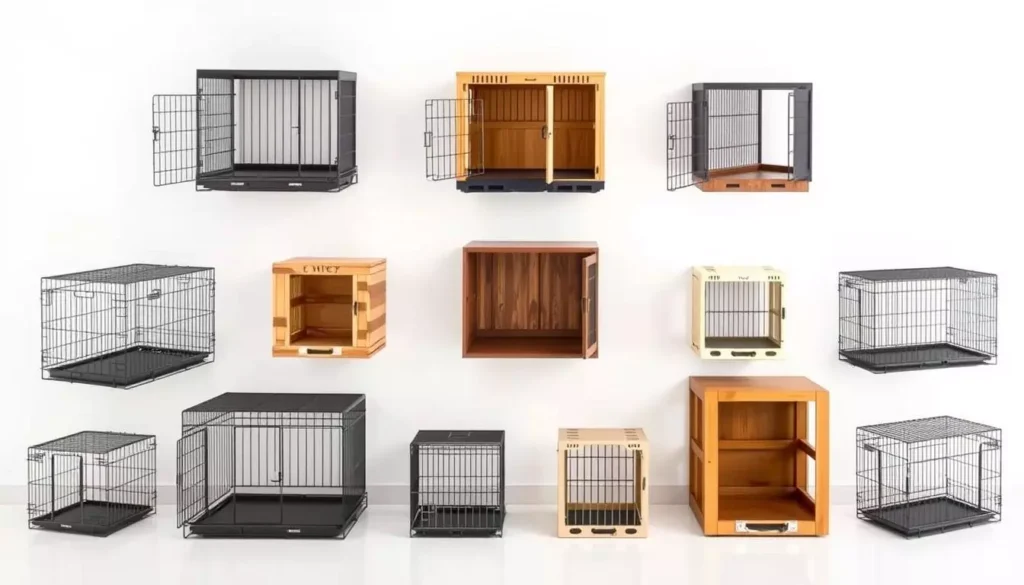
When picking an inside dog crate, size is most important. Your dog needs room to stand, turn, and lie down comfortably. Measure from nose to tail base, then add 2-4 inches for the best size.
- Wire Crates: Best for ventilation and visibility
- Plastic Crates: Ideal for travel and den-like environment
- Soft-Sided Crates: Lightweight and portable options
I suggest looking at these key features when choosing an inside dog crate:
| Feature | Importance |
|---|---|
| Removable Tray | Easy cleaning |
| Adjustable Divider | Accommodates puppy growth |
| Robust Construction | Durability and safety |
Pro tip: Pick a crate for your dog's adult size, but use a divider for puppies. This prevents too much space that might lead to bathroom accidents.
Creating a Positive Association with the Crate
Changing your dog's view of the crate from scary to cozy takes time and effort. It's all about making the crate a safe, happy place. This is especially true when starting crate training with an older dog.
Dogs love to have their own cozy spots. With the right approach, you can make the crate a special, secure area for them.
Introducing Your Dog to the Crate
Here's how to help your dog feel calm during crate training:
- Place the crate in a family-friendly area
- Leave the crate door open initially
- Allow natural exploration without forcing entry
- Use soft, encouraging tones
Using Treats and Rewards
Positive rewards are key to a happy crate experience. Here are some ideas:
| Reward Type | Purpose | Frequency |
|---|---|---|
| High-value treats | Encourage crate entry | First few training sessions |
| Favorite toys | Create positive associations | Daily crate time |
| Verbal praise | Reinforce good behavior | Consistently |
Making It a Comfortable Space
To make the crate inviting, add:
- Soft, washable bedding
- Familiar-smelling blankets
- Chew toys for entertainment
- Proper ventilation
"A crate should feel like a cozy den, not a punishment zone." - Professional Dog Trainer
Remember, consistency and positive reinforcement are your greatest tools in successful crate training.
Crate Training Dog: Step-by-Step Guide
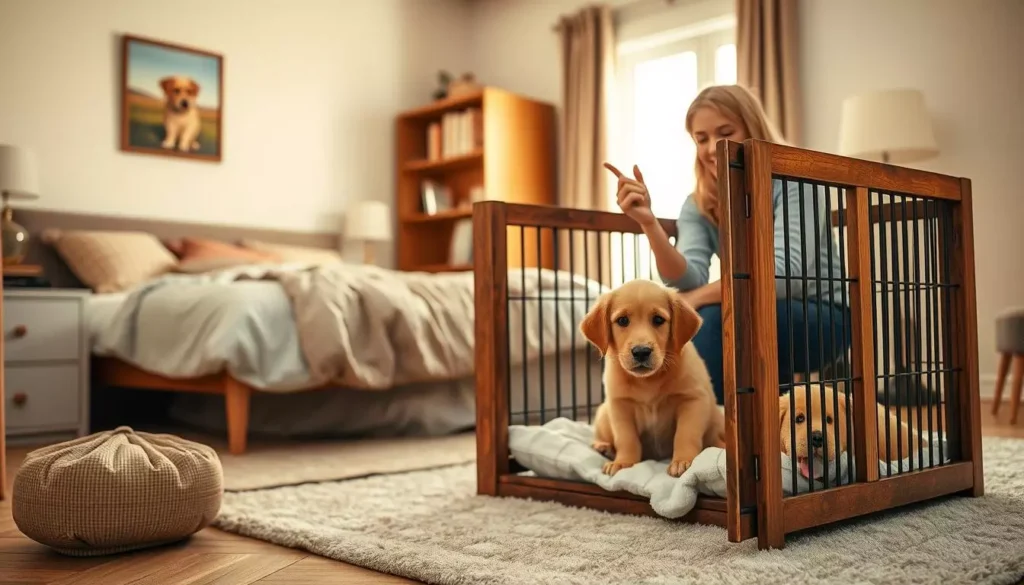
Crate training a dog needs patience and a smart plan. I'll show you a good way to make your dog feel safe and happy in their crate. The secret to success is making the crate a positive place and slowly increasing the time they spend in it.
Here are the main steps for crate training:
- Choose the right crate size for your dog
- Place the crate in a comfortable, quiet area
- Make the crate inviting with soft bedding
- Introduce short training sessions
Start with short 10-minute crate times for your dog. As they get used to it, you can make the time longer. Consistency is crucial in crate training.
| Dog Age | Recommended Crate Time | Training Approach |
|---|---|---|
| Puppy (8-16 weeks) | 10-15 minutes | Frequent short sessions |
| Adult Dog | 30-60 minutes | Gradual increase in duration |
Use treats and positive words during crate training. Make it a game where getting into the crate means a treat. This makes the crate a safe, fun place for your dog, not a punishment.
Remember, every dog is unique. Patience and understanding are your best tools in crate training.
Watch for signs of stress or discomfort. If your dog seems anxious, slow down the training. The aim is to make crate training a positive experience that strengthens your bond with your dog.
Essential Equipment and Setup Tips
Setting up the perfect inside dog crate takes careful planning. The right setup turns a simple crate into a cozy, safe spot for your dog.
Choosing the right spot for your dog's crate is key. I suggest picking a quiet area that's also close to family.
Strategic Crate Placement
- Select a quiet area with moderate family activity
- Avoid high-traffic zones and direct sunlight
- Keep away from heating vents or drafty areas
- Ensure the space is temperature-controlled
Bedding and Comfort Essentials
The inside of your dog crate should feel cozy. I recommend using:
- Soft, washable bedding
- Breathable materials
- Appropriately sized cushions
- Moisture-resistant bottom layer
Safety Considerations
Keeping your dog safe in the crate is crucial. Use zip ties to strengthen the crate edges and remove any dangers.
A well-prepared crate is more than a space—it's a safe haven for your canine companion.
Always check if your dog is comfortable and adjust as needed. The aim is to create a safe, welcoming space where your dog feels protected and relaxed.
Managing Time and Duration in the Crate
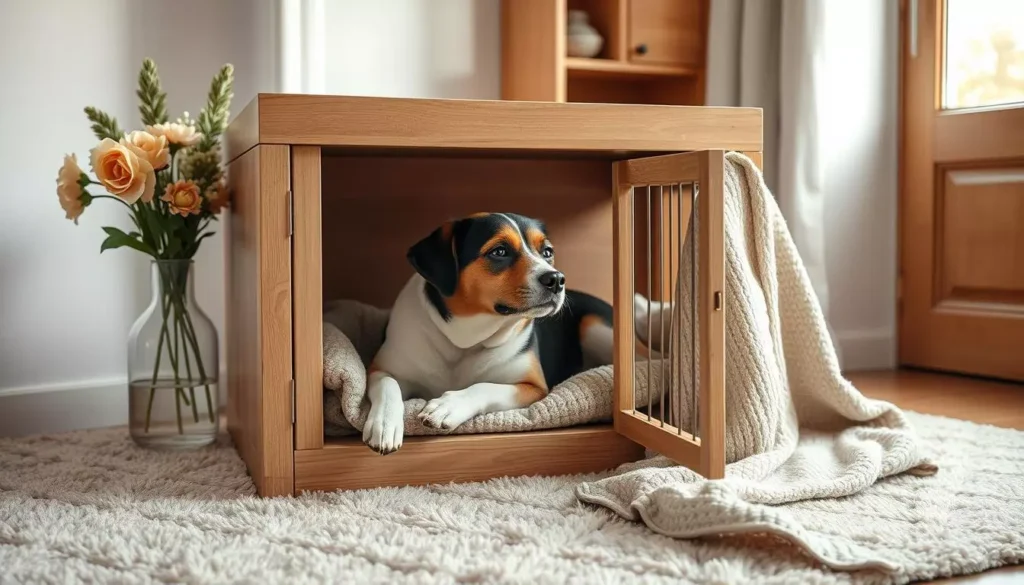
Knowing how long to leave your dog in a crate is key for their happiness and training success. Every dog is different, so finding the right balance is important.
Puppies and adult dogs need different amounts of crate time. Puppies should spend about one hour in a crate for every month of their age. For example, a 3-month-old puppy should not be in a crate for more than 3 hours a day. Adult dogs can usually handle 4-6 hours, but it depends on their personality and training.
- Puppy crate time: 1 hour per month of age
- Adult dog crate time: 4-6 hours maximum
- Nighttime crating: 7-8 hours for most adult dogs
Watch for signs of distress when figuring out crate time. If your dog whines a lot, seems restless, or tries to get out, they might need shorter crate times or more breaks.
"Crate training is about creating a safe space, not a punishment zone." - Professional Dog Trainer
If you work, plan for breaks or get a dog walker. Never keep your dog in a crate for too long without letting them go outside, exercise, and play.
Think about what your dog needs. Some dogs get used to crates fast, while others need more time. Always put your dog's comfort and happiness first when training.
Common Challenges and Solutions
Crate training can be tough for dog owners. Knowing how to handle these challenges makes it better for you and your dog. Every dog is different, so be patient and consistent.
Dealing with Whining and Barking
Understanding how to handle dog crying is key. How long do you let a dog cry when crate training? Wait for a break in whining before you act. This teaches your dog that crying doesn't always get a response.
- Ignore persistent whining
- Reward quiet moments
- Avoid reinforcing negative behavior
"Consistency is the key to successful crate training." - Professional Dog Trainer
Managing Crate Training Anxiety
Separation anxiety can make crate training hard. When wondering how long do you let a dog bark while crate training, remember to use gradual steps. Start with short crate times and increase them slowly.
- Begin with brief crate sessions
- Use calming techniques
- Create a comfortable environment
Nighttime Training Tips
Nighttime crate training needs a smart plan. Start by keeping the crate in your room for comfort. Create a bedtime routine that makes your dog feel safe and calm.
Remember, every dog is different. What works for one might not work for another. Stay patient, positive, and committed to your training.
Building a Consistent Routine
Crate training teaches your dog important life skills. It helps them learn discipline, patience, and how to manage their emotions. This is all thanks to a structured and predictable routine.
Having a consistent schedule is key for crate training success. Dogs love knowing what to expect, which reduces their anxiety and builds trust. It's a good idea to set specific times for crate use that fit into your daily routine.
- Set consistent crating times before meals
- Create a routine for crating during work hours
- Develop a predictable bedtime crating process
The main thing crate training teaches your dog is to see the crate as a safe, cozy space. By sticking to a routine, your dog learns to view the crate positively, not as a punishment.
| Time of Day | Crating Purpose | Duration |
|---|---|---|
| Morning | Pre-breakfast calm time | 15-30 minutes |
| Workday | While owner is away | 4-6 hours |
| Evening | Nighttime sleep | 8-9 hours |
Patience and consistency are your most powerful tools in crate training. Every dog learns at their own pace. So, be ready to make adjustments while keeping a steady routine.
Remember, a predictable routine helps your dog feel secure and understand expectations.
Advanced Training Techniques
After mastering basic crate training, you can move to more advanced methods. These techniques teach specific commands and make the crate a part of your dog's overall training.
It's a good idea to create a special crate command. This command should be more than just entering the crate. It helps your dog understand what you want and improves your communication.
- Create a unique verbal cue for crate entry
- Practice command repetition with gradual distance
- Reward precise and quick responses
Advanced crate training can help with specific issues. Targeted training uses the crate to manage anxiety, stop destructive behavior, and encourage calmness.
By using advanced techniques, you turn the crate into a training tool. Focus on making your dog confident and understanding through patient teaching.
Advanced crate training requires mental engagement and emotional intelligence from both dog and trainer.
Important advanced techniques include teaching your dog to enter the crate willingly. They should stay calm for a long time and see the crate as a safe place, not a punishment.
Conclusion
Crate training is a great way to make your dog feel safe and comfortable at home. It works best when you're patient and understand what your dog needs. This method can really change how your dog feels about being at home.
Learning to crate train your dog takes time and knowing what works for them. Every dog is different, so you need to find the right approach for your pet. It's not about keeping them locked up, but about giving them a cozy, safe place to relax.
Knowing how crate training helps your dog feel secure can strengthen your bond. Seeing the crate as a safe haven, not a punishment, boosts your dog's confidence. It's a way to invest in your dog's happiness and your relationship with them.
Every little bit of training makes a big difference. With patience, kindness, and regular practice, your dog will learn to love their own special space. It's all about creating a peaceful and loving home for both of you.

